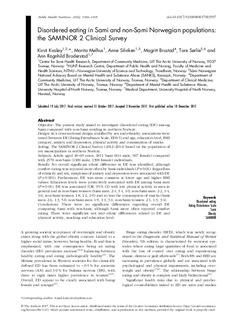| dc.contributor.author | Kvaløy, Kirsti | |
| dc.contributor.author | Melhus, Marita | |
| dc.contributor.author | Silviken, Anne | |
| dc.contributor.author | Brustad, Magritt | |
| dc.contributor.author | Sørlie, Tore | |
| dc.contributor.author | Broderstad, Ann Ragnhild | |
| dc.date.accessioned | 2018-06-01T06:07:48Z | |
| dc.date.available | 2018-06-01T06:07:48Z | |
| dc.date.created | 2017-12-19T08:35:38Z | |
| dc.date.issued | 2017 | |
| dc.identifier.citation | Public Health Nutrition. 2017, . | nb_NO |
| dc.identifier.issn | 1368-9800 | |
| dc.identifier.uri | http://hdl.handle.net/11250/2499976 | |
| dc.description.abstract | Objective
The present study aimed to investigate disordered eating (DE) among Sami compared with non-Sami residing in northern Norway.
Design
In a cross-sectional design, stratified by sex and ethnicity, associations were tested between DE (Eating Disturbance Scale; EDS-5) and age, education level, BMI category, anxiety and depression, physical activity and consumption of snacks.
Setting
The SAMINOR 2 Clinical Survey (2012–2014) based on the population of ten municipalities in northern Norway.
Subjects
Adults aged 40–69 years; 1811 Sami (844 male, 967 female) compared with 2578 non-Sami (1180 male, 1398 female) individuals.
Results
No overall significant ethnic difference in DE was identified, although comfort eating was reported more often by Sami individuals (P=0·01). Regardless of ethnicity and sex, symptoms of anxiety and depression were associated with DE (P<0·001). Furthermore, DE was more common at lower age and higher BMI values. Education levels were protectively associated with DE among Sami men (P=0·01). DE was associated (OR, 95% CI) with low physical activity in men in general and in non-Sami women (Sami men: 2·4, 1·4, 4·0; non-Sami men: 2·2, 1·4, 3·6; non-Sami women: 1·8, 1·2, 2·9) and so was the consumption of snacks (Sami men: 2·6, 1·3, 5·0; non-Sami men: 1·9, 1·1, 3·1; non-Sami women: 2·1, 1·3, 3·4).
Conclusions
There were no significant differences regarding overall DE comparing Sami with non-Sami, although Sami more often reported comfort eating. There were significant sex and ethnic differences related to DE and physical activity, snacking and education level. | nb_NO |
| dc.language.iso | eng | nb_NO |
| dc.publisher | Cambridge University Press (CUP) | nb_NO |
| dc.rights | Navngivelse 4.0 Internasjonal | * |
| dc.rights.uri | http://creativecommons.org/licenses/by/4.0/deed.no | * |
| dc.title | Disordered eating in Sami and non-Sami Norwegian populations: the SAMINOR 2 Clinical Survey | nb_NO |
| dc.type | Journal article | nb_NO |
| dc.type | Peer reviewed | nb_NO |
| dc.description.version | publishedVersion | nb_NO |
| dc.source.pagenumber | 12 | nb_NO |
| dc.source.volume | 21 | nb_NO |
| dc.source.journal | Public Health Nutrition | nb_NO |
| dc.source.issue | 6 | nb_NO |
| dc.identifier.doi | 10.1017/S1368980017003597 | |
| dc.identifier.cristin | 1529344 | |
| dc.description.localcode | © The Authors 2017. This is an Open Access article, distributed under the terms of the Creative Commons Attribution licence (http://creativecommons.org/licenses/by/4.0/), which permits unrestricted reuse, distribution, and reproduction in any medium, provided the original work is properly cited. | nb_NO |
| cristin.unitcode | 194,65,20,0 | |
| cristin.unitcode | 194,65,20,15 | |
| cristin.unitname | Institutt for samfunnsmedisin og sykepleie | |
| cristin.unitname | Helseundersøkelsen i Nord-Trøndelag | |
| cristin.ispublished | true | |
| cristin.fulltext | original | |
| cristin.qualitycode | 1 | |

